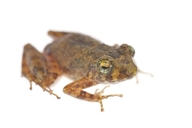|
Description
Oreobates cruralis is a frog where the female has an average snout-vent length of 29.3 +/- 2.0 mm, and the male has an average snout-vent length of 24.8 +/- 2.2 mm (Padial et al. 2008). Both female and male O. cruralis have round snouts as long as the diameter of the eye socket or “orbit”. Their heads are longer than they are wide (Boulenger 2009). They have coarse, warty skin (Padial et al. 2012).
Diagnosis:
To differentiate O. cruralis from congenerics, one may note that their third and fourth fingers have moderately enlarged tips and that they lack indented ungual flaps on the finger discs, unlike some congenerics (Padial et al. 2008). Additionally, their fingers are generally long with their first fingers not extending past their second. Additionally, they lack keratinized granules-- where the glands that serve as a source of their defensive secretions are hardened and raised (Toledo et al. 1995). They also have a different habitat from all congenerics, as they live in the humid forests of the lowlands and nearby foothills of the Andes (Padial et al. 2008), and have shorter feet. They lack bony bumps at the outer region of their ulnas (ulnar tubercles), which some species such as O. simmonsi have (Padial et al. 2008). They also can be distinguished by their bronze to golden colored iris (Padial et al. 2012), whereas species such as O. zongoensis have orange colored irises and are dark pinkish brown without markings (Reichle and Köhler 1997).
Coloration:
Oreobates cruralis are a brown to cream color, although their coloration may be variable, making it easy to confuse this species with others (Padial 2008). Additionally, they have darker symmetrical markings with a round whitish spot between their shoulders. Their lips have dark vertical bars and the limbs have dark cross-bars that form chevrons on the tibia. Their ventral region is greyish-brown (Boulenger 2009). The iris is bronze to golden (Padial et al. 2012)
Variation:
This species varies in adult size and coloration, which may lead to confusion with other species (Padial et al 2008).
Distribution and Habitat
Country distribution from AmphibiaWeb's database: Bolivia, Peru
Oreobates cruralis is found in subtropical or moist lowland forests adjacent to the Andes, spanning from southern Peru across central Bolivia (Padial 2008). Its currently listed upper elevation limit is 2,000 m.a.s.l., with a lower elevation limit of 200 m.a.s.l. (Vaira and Ferrari 2008).
Life History, Abundance, Activity, and Special Behaviors
The population trend of O. cruralis is considered stable, and locally this species varies from rare to abundant (IUCN 2020).
Oreobates cruralis calls from the ground or in low brushwoods, and breeds by direct development, leaving eggs in leaf-litter (IUCN 2020).
Trends and Threats
Although O. cruralis has been affected by habitat loss and alteration, these threats do not yet pose a major threat to this species. The species is sometimes common in disturbed areas, and are categorized as "Least Concern" by the IUCN (2020).
Comments
Phylogenetic relationships:
Phylogenetic revision of Oreobates genus frogs has been completed by Chaparro et al. (2015), Pereyra et al. (2014), Padial et al. (2012), and Padial et al. (2008). Based on the most recent of these studies, which made use of sequence data from seven genes across the mitochondrial and nuclear genomes, Oreobates genus frogs are sister to Lynchius, Phrynopus, and Hypodactylus genus frogs. The 2014 study, which sampled a greater diversity of Oreobates and made use of five genes from across the mitochondrial and nuclear genomes, found strong support for O. cruralis being most closely related to the congenerics O. discoidalis, O. ibischi, and O. barituensis.
Etymology:
The genus name, "Oreobates" comes from Greek, meaning "one that walks or hunts in the mountains" (Borror 1971).
The species epithet, "cruralis" comes from Latin, and refers to the the unique leg or shank of the species (Borror 1971).
References
Borror, D.J. (1971). Dictionary of Word Roots and Combining Forms. Mayfield Publishing Co
Boulenger, G.A. (1902). "Descriptions of new batrachians and reptiles from Andes of Peru and Bolivia." Journal of Natural History, 10(59), 394-402.
Chaparro, J. C., Padial, J. M., Gutierrez, R. C., De la Riva, I. (2015). "A new species of Andean frog of the genus Bryophryne from southern Peru (Anura: Craugastoridae) and its phylogenetic position, with notes on the diversity of the genus." Zootaxa, 3994(1), 94-108. [link]
Padial, J.M., Chaparro, J.C., Castroviejo-Fisher S., Guayasamin J.M., Lehr E., Delgado A.J., Vaira M., Texeira Jr. M., Aguayo R., De La Riva I. (2012). "A revision of species diversity in the neotropical genus Oreobates (Anura: Strabomantidae), with the description of three new species from the Amazonian slopes of the Andes." American Museum Novitates, 3752, 1-55. [link]
Padial, J.M., Chaparro, J.C., De La Riva, I. (2008). "Systematics of Oreobates and the Eleutherodactylus discoidalis species group (Amphibia, Anura), based on two mitochondrial DNA genes and external morphology." Zoological Journal of the Linnean Society, 152(4), 737-773. [link]
Pereyra, M. O., Cardozo, D. E., Baldo, J., Baldo, D. (2014). "Description and phylogenetic position of a new species of Oreobates (Anura: Craugastoridae) from northwestern Argentina." Herpetologica, 70(2), 211-227. [link]
Reichle, S., Köhler, J. (1997). ''A new species of Eleutherodactylus (Anura: Leptodactylidae) from the Andean slopes of Bolivia.'' Amphibia-Reptilia, 18, 333-337.
Toledo, R.C., Jared, C. (1995). "Cutaneous granular glands and amphibian venoms." Comparative Biochemistry and Physiology Part A: Physiology, vol. 111, no. 1. , 1-29.
Vaira M., Ferrari, L. (2008). "A new species of Oreobates (Anura: Strabomantidae) from the Andes of northern Argentina." Zootaxa, 1908, 41-50. [link]
Originally submitted by: Rachelle Smith, Emma Steigerwald (first posted )
Edited by: Ann T. Chang (2022-02-02)Species Account Citation: AmphibiaWeb 2022 Oreobates cruralis <https://amphibiaweb.org/species/2870> University of California, Berkeley, CA, USA. Accessed Jun 11, 2025.
Feedback or comments about this page.
Citation: AmphibiaWeb. 2025. <https://amphibiaweb.org> University of California, Berkeley, CA, USA. Accessed 11 Jun 2025.
AmphibiaWeb's policy on data use.
|






 Map of Life
Map of Life